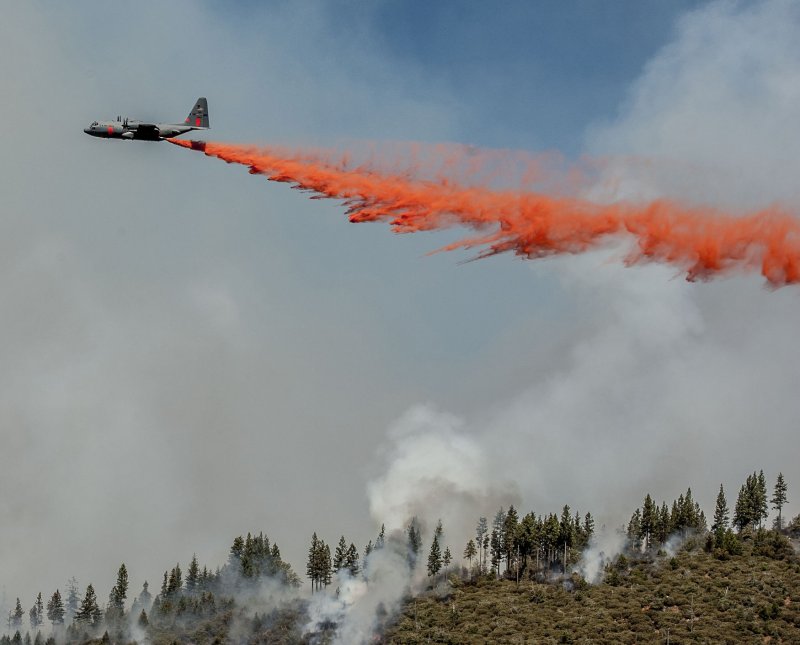1 of 2 | A National Guard C-130 tanker drops retardant to slow down active fire on Crocker Ridge below Pilot Peak near Yosemite National Park, California on August 28, 2013. Firefighters hope to hold fire with backfires on Crocker Ridge adjacent to Yosemite National Park and the Merced Grove of Big Trees in the next few days. UPI/Al Golub |
License Photo
JAMESTOWN, Calif., Aug. 30 (UPI) -- California's Yosemite National Park Rim fire has almost stopped growing but could flare again Friday as temperatures rise and humidity drops, officials said.
The central Sierra Nevada fire grew an average 23 acres an hour Thursday, down from burning an average 300 acres an hour Wednesday and 1,000 acres an hour Tuesday, the California Department of Forestry and Fire Protection said.
At its peak last week, the ravenous fire consumed 3,000 acres an hour.
Cooling temperatures, higher humidity and persistent work from some 4,800 firefighters combined to help slow the flames, said a spokesman for the agency, known as Cal Fire.
Evacuation advisories were lifted Thursday for Tuolumne City and former California Gold Rush towns of Soulsbyville and Willow Springs.
But temperatures, in the 80s Thursday, were expected to rise into the 90s again Friday and the humidity was forecast to drop.
That would help the flames spread and could wear out firefighters in the field, Cal Fire spokesman Daniel Berlant told the San Jose Mercury News.
The fire could explode again if it reaches the base of a hill, where it can race upward, or into a canyon, which would act like a chimney, said a spokesman for the U.S. Forest Service, which is leading the response with Cal Fire.
"That potential is still out there," Dick Fleishman told the newspaper. "There's a lot of work that still needs to be done."
The nearly 2-week-old fire, which has burned more than 300 square miles, is spreading to the east, deeper into the national park, and west, threatening homes along rural state Route 108, the San Francisco Chronicle reported.
Acting Gov. Darrell Steinberg, the state Senate president pro tem, declared a state of emergency for Mariposa County, in the Sierra Nevada western foothills.
Gov. Jerry Brown, who was out of the state, last week declared emergencies in Tuolumne and San Francisco counties. San Francisco was included because it controls the 117 billion-gallon Hetch Hetchy Reservoir in Yosemite, the source of water for 2.6 million Bay Area residents and businesses from San Francisco south to Silicon Valley.
Ash kept falling into the reservoir from the fire burning around the southern and western shores Thursday, but officials insisted the water's quality was not compromised.
The blaze remains 30 percent contained, the same as Wednesday. The estimate for full containment was changed to three weeks from now instead of two.
Smoke is drifting northeast over Lake Tahoe, some 100 miles away. Air-quality warnings were issued for Nevada cities on the eastern side of the Sierra, including Reno and Carson City.
No structures have burned since earlier this week, when officials reported 111 were destroyed -- mostly small cabins and outbuildings.
The blaze is the nation's largest active forest fire and the sixth-largest fire in California history, dating from 1932.
The cause of the Rim fire, which started in the Stanislaus National Forest Aug. 17, is under investigation.















